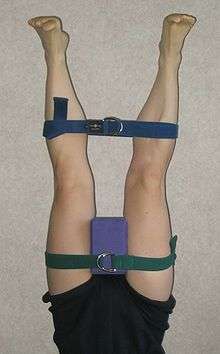Iyengar Yoga
| Iyengar Yoga | |
|---|---|
| Founder | B. K. S. Iyengar |
| Established | 1970s |
| Derivative forms | Anusara Yoga, Forrest Yoga |
| Practice emphases | |
| great attention to detail and precise focus on body alignment often with the use of props | |
| Related schools | |
| Ashtanga Vinyasa Yoga | |

Iyengar Yoga, named after and developed by B. K. S. Iyengar, is a form of Hatha Yoga that has an emphasis on detail, precision and alignment in the performance of posture (asana) and breath control (pranayama). The development of strength, mobility and stability is gained through the asanas.
B.K.S. Iyengar has systematised over 200 classical yoga poses and 14 different types of Pranayama (with variations of many of them) ranging from the basic to advanced. This helps ensure that students progress gradually by moving from simple poses to more complex ones and develop their mind, body and spirit through a step-by-step approach.[1]
Iyengar Yoga often makes use of props, such as belts, blocks, and blankets, as aids in performing asanas (postures). The props enable students to perform the asanas correctly, minimising the risk of injury or strain, and making the postures accessible to both young and old.
Iyengar Yoga is firmly based on the traditional eight limbs of yoga as expounded by Patanjali in his Yoga Sutras.
Focus

Iyengar Yoga is a form of Hatha Yoga in which there is a focus on the structural alignment of the physical body through the development of asanas. Through the practice of a system of asanas, it aims to unite the body, mind and spirit for health and well-being. The discipline is considered by its practitioners to be a powerful tool to relieve the stresses of modern-day life, in turn helping to promote total physical and spiritual well-being.[2]
It can be said that Iyengar differs from the other styles of yoga by three key elements: technique, sequence and timing.
- Technique refers to the precision of the body alignment and the performance of pranayama.
- Sequence means the sequences in which asanas and breathing exercises are practiced. Following the specific sequence is important in achieving the desired result, because only the combination of certain poses and breathing techniques can ensure the expected positive effect.
- Timing is the third key element which defines the time spent in each pose or pranayama.[1]
Iyengar Yoga is characterized by great attention to detail and precise focus on body alignment. Iyengar pioneered the use of "props" such as cushions, benches, blocks, straps and sand bags, which function as aids allowing beginners to experience asanas more easily and fully than might otherwise be possible without several years of practice. Props also allow elderly, injured, tired or ill students to enjoy the benefits of many asanas via fully "supported" methods requiring less muscular effort.
Unlike more experiential approaches where students are encouraged to independently "find their way" to the asanas by imitating the teacher, an Iyengar Yoga class is highly verbal and precise, with misalignments and errors actively corrected. Iyengar teachers complete at least two years of rigorous training for the introductory certificate. They may complete subsequent intermediate levels and senior levels of certification, potentially entailing a decade or more of training.
References
External links
- B.K.S. Iyengar's Official website
- BBC World Service article and programme by Mark Tully
- Iyengar among TIME's top 100 people
- Interview with Iyengar on CNN
- Denver Post article
- Interview with BKS Iyengar by IBNlive news channel
- Interview with BKS iyengar by Noa Zweig, Pune 2012